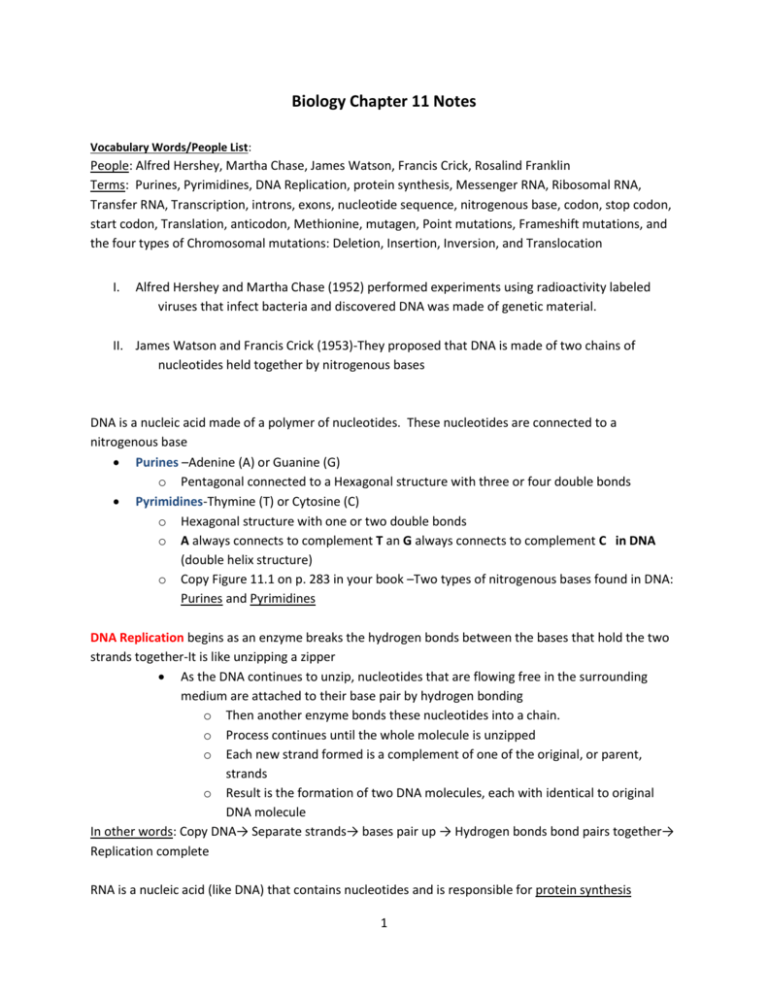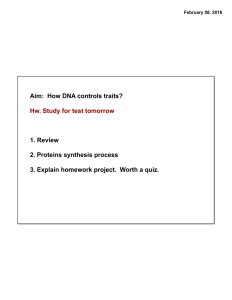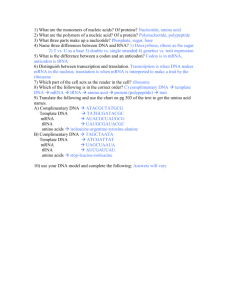BiologyChapter11Notes&Voc
advertisement

Biology Chapter 11 Notes Vocabulary Words/People List: People: Alfred Hershey, Martha Chase, James Watson, Francis Crick, Rosalind Franklin Terms: Purines, Pyrimidines, DNA Replication, protein synthesis, Messenger RNA, Ribosomal RNA, Transfer RNA, Transcription, introns, exons, nucleotide sequence, nitrogenous base, codon, stop codon, start codon, Translation, anticodon, Methionine, mutagen, Point mutations, Frameshift mutations, and the four types of Chromosomal mutations: Deletion, Insertion, Inversion, and Translocation I. Alfred Hershey and Martha Chase (1952) performed experiments using radioactivity labeled viruses that infect bacteria and discovered DNA was made of genetic material. II. James Watson and Francis Crick (1953)-They proposed that DNA is made of two chains of nucleotides held together by nitrogenous bases DNA is a nucleic acid made of a polymer of nucleotides. These nucleotides are connected to a nitrogenous base Purines –Adenine (A) or Guanine (G) o Pentagonal connected to a Hexagonal structure with three or four double bonds Pyrimidines-Thymine (T) or Cytosine (C) o Hexagonal structure with one or two double bonds o A always connects to complement T an G always connects to complement C in DNA (double helix structure) o Copy Figure 11.1 on p. 283 in your book –Two types of nitrogenous bases found in DNA: Purines and Pyrimidines DNA Replication begins as an enzyme breaks the hydrogen bonds between the bases that hold the two strands together-It is like unzipping a zipper As the DNA continues to unzip, nucleotides that are flowing free in the surrounding medium are attached to their base pair by hydrogen bonding o Then another enzyme bonds these nucleotides into a chain. o Process continues until the whole molecule is unzipped o Each new strand formed is a complement of one of the original, or parent, strands o Result is the formation of two DNA molecules, each with identical to original DNA molecule In other words: Copy DNA→ Separate strands→ bases pair up → Hydrogen bonds bond pairs together→ Replication complete RNA is a nucleic acid (like DNA) that contains nucleotides and is responsible for protein synthesis 1 RNA differs from DNA in three ways: 1. RNA is single stranded (DNA is double stranded-double helix) 2. RNA has a different sugar-Ribose (DNA has a Deoxyribose sugar) 3. Both contain nitrogenous bases but RNA uses Uracil (U) to pair with (A) Adenine instead of (T)Thymine in DNA There are three types of RNA 1. Messenger RNA (mRNA)-brings instructions from DNA to the cytoplasm where ribosomes are located mRNA carries this information to the nuclear envelope to the ribosomes in the cytoplasm Very short in bacteria Much longer in eukaryotes 2. Ribosomal RNA (rRNA)-Binds to the mRNA and makes the amino acids in the correct order 3. Transfer RNA (tRNA)-This type sends amino acids to the ribosomes to make the proteins Each tRNA molecule attaches to only one type of amino acid (20 different types of amino acids) Transcription The process that occurs in the nucleus, where enzymes make a RNA copy of a portion of DNA Genes in eukaryotic cells contain nucleotides (found in DNA). Some nucleotides carry instructions to make proteins and some don’t. The ones that do not have genetic codes are called introns o Splicing occurs as introns are removed forming split pieces Regions of genetic codes are called exons When mRNA is under going Transcription from DNA both introns and exons are copied The introns must be removed from the mRNA before it can function to make a protein. o Enzymes in the nucleus cut out the introns segments and paste the mRNA back together o The mRNA then leaves the nucleus and travels to the ribosome. The nucleotide sequence transcribed from DNA to a strand of mRNA acts like a genetic message, the complete information for the building of a protein. o There are 20 common types of amino acids and a code is needed to convert the language of mRNA into a language of proteins o The code is actually three nitrogenous bases pairs called codon in mRNA to determine the which type of amino acid will be formed 64 combinations are possible Ex. UAA , UAG, and UGA are all stop codons and AUG, is the start codon 2 More than one codon can code the same amino acid but for any one codon, there can be only one amino acid For this reason scientists have determined that all organisms originated from one common origin Translation: From mRNA to Protein The process of converting the information in a sequence of nitrogenous bases in mRNA into a sequence of amino acids in proteins Takes place at the ribosomes in the cytoplasm In prokaryotic cells, the mRNA are made in the cytoplasm (no complete nucleus) In eukaryotic cells, the mRNA is made in the nucleus and travels to the cytoplasm o In the cytoplasm, a ribosome attaches to the strand of mRNA like a clothespin clamped into a clothesline o Molecules of tRNA , each carrying a specific amino acid approach the ribosome The anticodon forms a base pair with the codon of the mRNA strand The anticodon places the amino acid in the correct position form the formation of a peptide bond o The codon such as AUG, which codes from the amino acid Methionine, starts the protein synthesis process o The tRNA molecule carrying Methionine attaches to the ribosome and mRNA strand o A new tRNA molecule carrying an amino acid attaches to the ribosome and mRNA strand next to the previous tRNA molecule. o The amino acid on the tRNA molecules are joined by peptide bonds o After that, the ribosome slides along the mRNA molecule to the next codon. And a new tRNA molecule brings another amino acid The amino acid bond; the first tRNA releases its amino acid and detaches from the mRNA The tRNA molecule is now free to pick up and deliver another molecule o The process continues forming a chain of amino acids until the stop codon reaches the tRNA. o The amino acid chains become proteins when they are freed from the ribosome and twist and curl into complex 3-D shapes. Each protein chain forms the same shape every time it is produced The proteins become enzymes and cell structures Mutations Any change in the DNA sequence Error is from cell division, replication, transcription, or by external agents such as environmental factors o Any agent that can change a change in DNA is called a mutagen 3 X-rays, extreme temperature, chemicals (dioxins, asbestos, benzene, and formaldehyde) and other forms of radiation (sunlight, ultraviolet, and nuclear) In humans, only negative effects can occur-usually death occurs in sex cells Some plants have positive effects of mutations so scientists try to replicate these mutations Types of Mutations 1. Point mutations is a change in a single base pair in DNA Problem is that the whole protein structure is altered making it function improper or not at all-Can cause the cell to die or mutate o When cells divide, it passes on the mutation. o Scientists believe that the build up of mutations in body cells plays a role in aging Less harmful than Frameshift mutations 2. Frameshift mutations occurs when a single base is added to or deleted from DNA Problem occurs because it shifts the reading of the codons by one base which can change every amino acid on that chain Can kill or alter body cells –Can even cause illnesses such as Cancer 3. Chromosomal mutations are changes made to chromosomes and genes Commonly found in plants and rarely in humans o If found in humans the zygote usually dies o If the human does survive he or she is often sterile (unable to have children) 4 types of Chromosomal mutations 1. Deletion –occurs when part of a chromosome is left out 2. Insertion-occurs when part of a chromatid breaks off and attaches to its sister chromatid. It causes a duplication of genes on the same chromosome 3. Inversion-occurs when part of a chromosome breaks off and reattaches backwards 4. Translocation-occurs when part of one chromosome breaks off and is added to a different chromosome --------------------------------------------------------------------------------------------------------------------------------------Read BIO Technology on p. 304 Teacher book and answer the following questions: (Turn in as a Classwork grade) 1. What were the accomplishments of Rosalind Franklin? 2. Why was Rosalind Franklin’s work so dangerous? 3. Explain the advancements of X-ray technology from the 1950’s to today. 4








